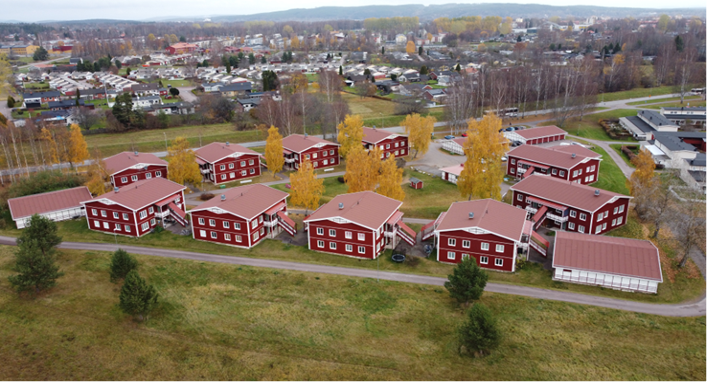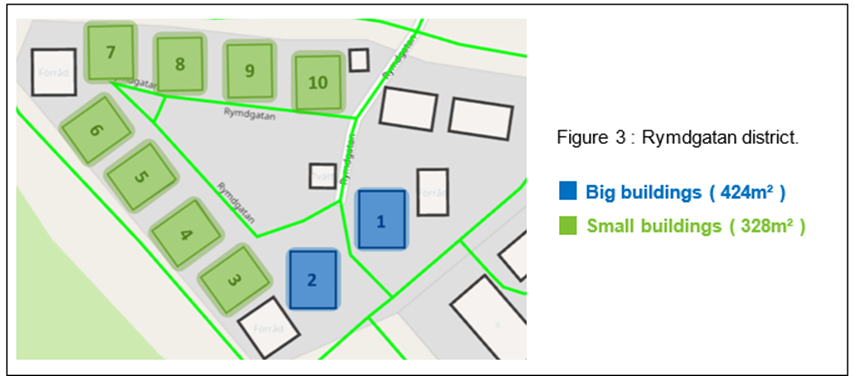Borlänge
Borlänge
Pilot case: Rymdgatan community in Jakobsgårdarna district
Introduction
In Sweden, the concept of “energy prosumers” is taking centre stage, showcasing the country’s commitment to innovative and hyper-local energy solutions that go beyond just village-level heating. What makes this transformation particularly noteworthy is that these buildings have essentially become “prosumers.” They now generate more energy than they consume, meeting an impressive 77% of the residents’ energy needs. This achievement is further bolstered by the widespread adoption of smart meters, which enable precise monitoring and optimization of energy usage. By harnessing local energy resources and advanced technology, Sweden is setting the stage for a more energy-efficient and environmentally conscious future (Kretchmer, 2020).
One critical aspect of the regional approach to sustainable development in Dalarna is the formulation of a comprehensive energy and climate strategy. This strategy outlines a long-term vision for the year 2050, envisioning Dalarna as a place where living in an “energy intelligent and climate smart” manner is not just encouraged but has become second nature to its residents(Dalarna Network for Sustainable Consumption, n.d.). This approach recognizes that sustainability is not a short-term objective but a profound shift in the way people interact with their environment. It requires a fundamental transformation of behaviors and choices, both at the individual and community levels, emphasizing eco-conscious living and responsible resource management.
Furthermore, Dalarna’s commitment to sustainability extends beyond its own boundaries. It aligns itself with Sweden’s broader national agenda, exemplified by the “The Dala Strategy 2030” set by the government(Dalarna, 2030). This national commitment seeks to create a society where the consumption of goods and services has minimal adverse effects on the environment and human health. It underscores the significance of responsible consumption and sustainable production practices in addressing the environmental and social challenges associated with modern lifestyles.
Considering this context, the Jakobsgårdarna area presents an ideal candidate for a baseline PED case study. The community’s alignment with Dalarna’s energy and climate strategy, as well as its commitment to the Generational Goal, makes it a compelling example of how sustainable living principles can be put into practice. Studying Jakobsgårdarna’s journey towards energy efficiency and climate resilience can provide valuable insights and serve as an inspiration for other regions and communities striving to achieve similar sustainability goals. It showcases the tangible results of a community’s dedication to “energy intelligent and climate smart” living within the framework of a larger regional and national vision.
Location, socio-techs covered:
Since the 1980s, Jakobgårdarna has primarily served residential purposes. It enjoys a strategically central location within the city, offering convenient access to both commercial and public services. In collaboration with PED-ACT partners, the municipal authority, ‘Borlänge Kommun,’ through its public construction sector, planning department, and land office, has envisioned a comprehensive development plan for this district. This initiative is driven by the presence of a substantial land reserve, which holds significant potential for the creation of housing units and the integration of various social and economic activities.
Energy specifications 2022:
We focus on Rymdgatan community in Jakobgårdarna district. There are 10 buildings in total which are multi-family houses with a total combined floor area for all these buildings amounts to 3,700 square meters. The annual district heating demand for these buildings is 615 MWh, covering both space heating and hot water requirements, with an area-specific demand of 169 kWh/m2/year. Electricity for these buildings is sourced from the grid, with no photovoltaic (PV) solar panels on the roofs. The annual electrical demand for these multi-family houses is 33 MWh, resulting in an area-specific electrical demand of 10 kWh/m2/year. A short summary is listed in table 1.
Orientation

Figure 1. Map of Borlänge and the red marker is the pilot study area. Source: OpenStreetMap

Figure 2. Buildings considered in the Case study
Potential PED area selection

The initial step in this process involves precisely identifying the location designated for the study area. In our specific study, the district consists of various buildings that can be categorized into two groups. The first group comprises two are larger with an area of 424 square meters while the other are eight smaller constructions, each with an area of 328 square meters, as depicted in Figure 2.
Furthermore, it’s important to note that the simulation will not include the laundry facility within the district. This omission may result in some variations in both electricity and heating consumption. This decision was made because the construction standards for the laundry facility and the necessary information for an accurate simulation were not provided. It was also assumed that the exclusion of the laundry facility would not significantly impact the overall results.
County context
In line with the municipalities vision to contribute to a sustainable society, the appointed municipal manager assumes the pivotal responsibility of formulating a meticulous action plan for environmental strategy implementation. It is imperative to emphasize that the implementation process adheres to the established chain of command and regulatory framework, much like other initiatives within the municipal group. Guidelines, owner directives, delegation of authority, and related protocols govern the decision-making process concerning the execution of the environmental strategy. Consequently, any necessary political decisions required for the successful implementation of the environmental strategy fall under the purview of the respective responsible committee (Miljöstrategi 2021-2030). The aspiration is for this structured approach to serve as a beacon, illustrating the commitment to societal well-being through the diligent execution of the environmental strategy.
National context
To attain Sweden’s ambitious goal of achieving carbon neutrality by 2045, various initiatives, programs, and legislations have been introduced by both the government and society. Among these innovative pro-grams is ‘Viable Cities,’ which is designed with the mission of assisting cities in reaching carbon neutrality by 2030 while simultaneously enhancing the quality of life for all residents. Viable Cities represents a groundbreaking initiative in Sweden that is intrinsically linked to the concept of PEDs as a means to achieve sustainability and carbon neutrality. As of October 2021, a total of 23 cities in Sweden, including Borlänge, have entered into climate-neutral agreements. These agreements have been made possible through the support and collaboration of the Swedish Energy Agency and the Viable Cities program (PED).
References
Dalarna Network for Sustainable Consumption. (n.d.).
Dalarna, R. (2030). THE DALA STRATEGY 2030 Together for a sustainable Dalarna Cohesive A sustainable Dalarna with development capacity in every part of the county.
Energy Positive Districts and Neighbourhoods for Sustainable Urban Development (PED). (n.d.).
Kretchmer, H. (2020, September 21). Transforming homes into power stations – how Sweden is disrupting energy production.
Miljöstrategi 2021-2030. (n.d.).
Energy Calculations of the Rymdgatan community
Tools
The Rymdgatan community in Jakobsgårdarna district is assessed using the City Energy Analyst (CEA) tool (shown in Figure 1). Three key strategies are examined: Building Retrofit (Strategy I), Exploration of Local Solar Sources (Strategy II), and Heating Supply Optimization with Solar Technologies (Strategy III). By employing quantitative assessments, we evaluate the energy, carbon, and provide rough estimates for both the capital expenditure (Capex) and operational expenditures (Opex) of various urban energy infrastructure design scenarios. We consider factors such as individual building efficiency improvement, operational climate impact, renewable energy potential, and electrifying energy supply system.

Figure 1. Flowchart of the simulation in CEA tool
Building Retrofit (Strategy I) demonstrates a 32% reduction in individual building peak demand, contributing to a 39% decrease in annual specific primary energy and a substantial 26% reduction in annual specific GHG emissions. Exploration of Local Solar Sources (Strategy II) highlights the potential of solar technology integration, emphasizing strategic placement for optimal energy production (as illustrated in Figure 2). Heating Supply Optimization (Strategy III) introduces heat pumps to balance temporal energy asymmetry, showcasing remarkable reductions in emissions and primary energy consumption. The integrated strategies provide a comprehensive blueprint for achieving positive energy districts, offering valuable insights for sustainable urban development and guiding policymakers, urban planners, and stakeholders in transitioning towards low-carbon and energy-efficient communities.
Figure 2. Inter-Shading situation happens on the spring equinox

Dalarna Network for Sustainable Consumption. (n.d.).
Dalarna, R. (2030). THE DALA STRATEGY 2030 Together for a sustainable Dalarna Cohesive A sustainable Dalarna with development capacity in every part of the county.
Energy Positive Districts and Neighbourhoods for Sustainable Urban Development (PED). (n.d.).
Kretchmer, H. (2020, September 21). Transforming homes into power stations – how Sweden is disrupting energy production.
Miljöstrategi 2021-2030. (n.d.).
